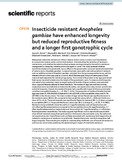| dc.contributor.author | Osoro, Joyce K. | |
| dc.contributor.author | Machani, Maxwell G. | |
| dc.contributor.author | Ochomo, Eric | |
| dc.contributor.author | Wanjala, Christine | |
| dc.contributor.author | Omukunda, Elizabeth | |
| dc.contributor.author | Githeko, Andrew K. | |
| dc.contributor.author | Yan, Guiyun | |
| dc.contributor.author | Afrane, Yaw A. | |
| dc.date.accessioned | 2022-07-13T05:15:11Z | |
| dc.date.available | 2022-07-13T05:15:11Z | |
| dc.date.issued | 2022-05-23 | |
| dc.identifier.uri | https://doi.org/10.1038/s41598-022-12753-w | |
| dc.identifier.uri | https://www.nature.com/articles/s41598-022-12753-w#Sec2 | |
| dc.identifier.uri | http://ir-library.mmust.ac.ke:8080/xmlui/handle/123456789/2054 | |
| dc.description.abstract | Widespread insecticide resistance in African malaria vectors raises concerns over the potential to compromise malaria vector control interventions. Understanding the evolution of resistance mechanisms, and whether the selective disadvantages are large enough to be useful in resistance management or designing suitable control strategies is crucial. This study assessed whether insecticide resistance to pyrethroids has an effect on the gonotrophic cycle and reproductive potential of malaria vector Anopheles gambiae. Comparative tests were performed with pyrethroid-resistant and susceptible colonies of Anopheles gambiae colonized from the same geographical area, and the reference Kisumu strain was used as a control. Adult females aged 3 days old were given a blood meal and kept separately for individual egg-laying. The number of days taken to lay eggs post-blood-feeding was recorded to determine the length of the gonotrophic cycle. To measure adult longevity and reproduction potential, newly emerged males and females of equal numbers were aspirated into a cage and females allowed to blood feed daily. The number of eggs laid and the surviving mosquitoes were recorded daily to determine fecundity, net reproduction rate, intrinsic growth rate and adult longevity. Overall, the resistant females had a significantly longer (1.8 days) gonotrophic cycle than susceptible females (F2, 13 = 9. 836, P < 0.01). The proportion of resistant females that laid eggs was lower 31.30% (94/300) compared to 54% (162/300) in the susceptible colony and 65.7% (197/300) in the Kisumu strain. The mean number of eggs laid per female was significantly lower in the resistant colony (88.02 ± 20) compared to the susceptible colony (104.9 ± .28.8) and the Kisumu strain (97.6 ± 34.8). The adult longevity was significantly higher for resistant (39.7 ± 1.6 days) compared to susceptible (29.9 ± 1.7 days) and the Kisumu strain was (29.6 ± 1.1 days) (F2,8 = 45.05, P < 0.0001). Resistant colony exhibited a lower fecundity (4.3 eggs/females/day) and net reproductive rate (2.6 offsprings/female/generation) compared to the susceptible colony (8.6 eggs/female/day; 4.7 offsprings/female/generation respectively) and Kisumu strain (9.7 eggs/female/day; 4.1 offsprings/female/generation respectively). The study suggests high fitness cost on reproductive parameters of pyrethroid-resistant mosquitoes particularly on the duration of gonotrophic cycle, fecundity and net reproductive rate. These fitness costs are likely associated with maintaining both target site and metabolic mechanisms of resistance to pyrethroids. Despite these costs, resistant mosquitoes had longer longevity. These results give insights to understanding the fitness cost of insecticide resistance and thus are critical when predicting the epidemiological impact of insecticide resistance. | en_US |
| dc.language.iso | en | en_US |
| dc.publisher | scientific reports | en_US |
| dc.subject | Insecticide, resistant, Anopheles, gambiae, enhanced, longevity, reproductive, fitness , longer, gonotrophic, cycle | en_US |
| dc.title | Insecticide resistant Anopheles gambiae have enhanced longevity but reduced reproductive fitness and a longer first gonotrophic cycle | en_US |
| dc.type | Article | en_US |

